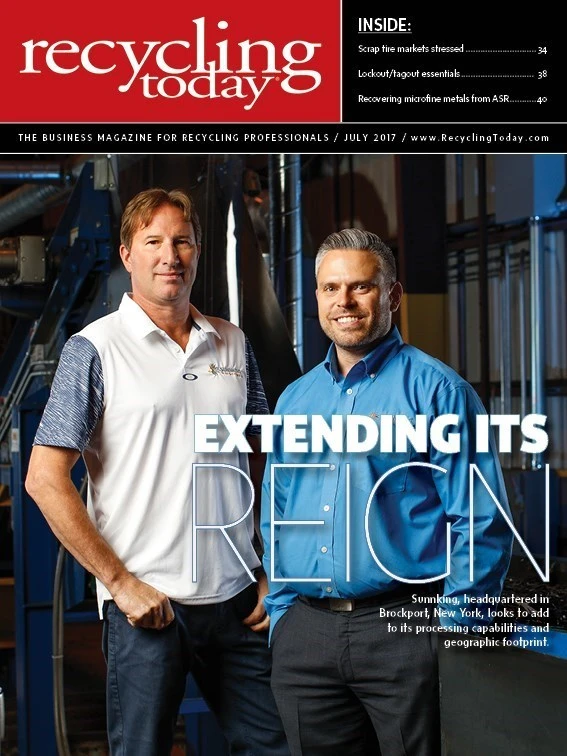The first half of 2017 has included a new presidential administration setting different priorities in Washington, several European
Amidst the geopolitical uncertainty, pricing in the steel and ferrous scrap market has been comparatively stable, as has demand for and the supply of scrap. Pricing released in late May 2017 calculated by Pittsburgh-based Management Science Associates (MSA) as part of its Raw Material Data Aggregation Service (RMDAS), showed almost no ferrous scrap price movement during the month of May
American Metal Market (AMM), in the indices it created to measure early June buying activity, found narrow (less than $2 per ton) changes in its export indices and similar shifts in its Midwest indices, with one exception: the value of shredded scrap in the Midwest fell by $11 per ton.
“In the U.S. there is good demand and underlying strength in the steel sector, and the rest of the year is looking stable.” – Tom Bird of U.K.-based Liberty Steel
Speakers at the Ferrous Division meeting of the 2017 Bureau of International Recycling (BIR) World Recycling Convention, held in late May in Hong Kong, referred to recent geopolitical turmoil as well as to a ferrous market that has provided smoother sailing in recent months.
William Schmiedel, the BIR Ferrous Division president who also works from New York for Sims Metal Management, referred to 2017 as a year when governments around the world are “playing an increasing role” in the steel industry.
Despite, or in some cases because of, the government actions, demand for steel and ferrous scrap has been stable to rising in 2017, according to Ferrous Division meeting presenters.

Schmiedel referred to the Chinese government’s “never-ending stimulus package” as a factor in that nation consuming more of its own steel. China also has been shutting down smaller, induction furnace steelmakers to rein in capacity and limit emissions. Adding a cautionary note, Schmiedel said ferrous scrap traders “must be mindful” that government activities mean “things change and paradigms will shift.”
Reading a collection of market reports from around the world, Tom Bird of United Kingdom-based Liberty Steel said Chinese financial sector restrictions may create pressure for steelmakers there “to sell inventories due to increased short-term borrowing costs.” As Schmiedel also noted, however, Chinese “One Belt, One Road” infrastructure projects could help absorb much of this steel.
Bird said mill buyers in India “have gone quiet for June bookings” after a “flurry” of activity in April. Buyers in Turkey increased their purchases by 2.6 percent in the first quarter of 2017 compared with 2016.
Imports from the United States, however, were down by nearly 6 percent, and from the U.K. they plummeted by nearly 24 percent. The winner was continental Europe, with the Netherlands, Belgium, Denmark, France and Germany combining to ship more than 1.5 million metric tons of ferrous scrap to Turkey in the first quarter, almost double the U.S. volume.

Summarizing the current market, Bird said, “The outlook for 2017 remains relatively positive. Demand should stay healthy, and there is a good scrap supply-demand balance.” He continued, “In the U.S. there is good demand and underlying strength in the steel sector, and the rest of the year is looking stable.”
Ferrous Division guest speaker Chen Ye of the Shanghai Futures Exchange (SHFE) said steelmakers seeking better return on investment should consider Nucor’s scrap-based model, which has demonstrated good financial results this decade compared with many other steel producers. “So maybe Chinese steel companies will consider using more steel scrap in order to control costs,” he said.
Chen also said a scrap futures trading contract can play an important role in the sector’s future. He pointed to the positive development of SHFE’s steel rebar contract, which he called “the most actively traded ferrous metal futures [contract] in the world.” In 2016, Chen said, the SHFE rebar contract “registered 43.3 million contracts (covering 433 million metric tons of material).”
Nathan Fruchter of Idoru Trading Corp., New York, a guest speaker, provided a retrospective of the changes he has seen after decades in the ferrous scrap business. He commented on the role of Telex machines in the 1980s and changes in global scrap flows during the past 40 years.
In the 1980s, Spain,
Sponsored Content
Labor that Works
With 25 years of experience, Leadpoint delivers cost-effective workforce solutions tailored to your needs. We handle the recruiting, hiring, training, and onboarding to deliver stable, productive, and safety-focused teams. Our commitment to safety and quality ensures peace of mind with a reliable workforce that helps you achieve your goals.
In 2000, newcomers accepting U.S. scrap included China and Ecuador, with Vietnam joining the mix by 2010. From the ferrous scrap price index viewpoint, he said South Korean buyers played an important part in the 1990s in a role that was later usurped by Turkish mills.
Get curated news on YOUR industry.
Enter your email to receive our newsletters.

Explore the July 2017 Issue
Check out more from this issue and find your next story to read.
Latest from Recycling Today
- ReMA opposes European efforts seeking export restrictions for recyclables
- Fresh Perspective: Raj Bagaria
- Saica announces plans for second US site
- Update: Novelis produces first aluminum coil made fully from recycled end-of-life automotive scrap
- Aimplas doubles online course offerings
- Radius to be acquired by Toyota subsidiary
- Algoma EAF to start in April
- Erema sees strong demand for high-volume PET systems







